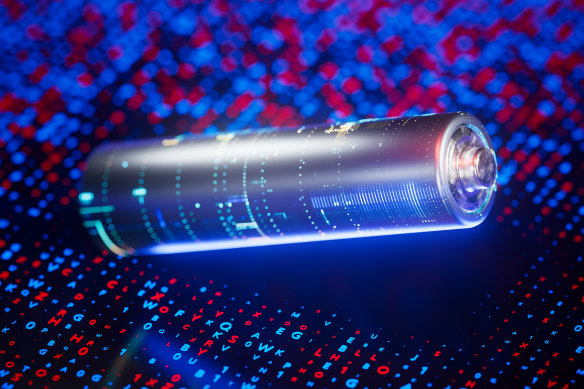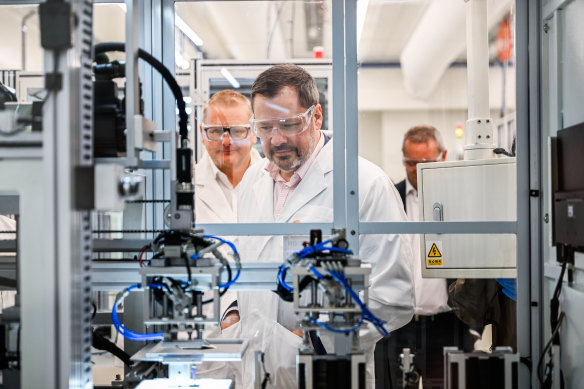This was published 11 months ago
Twice the grunt or half the weight – Australia’s plans to build a better battery
By Mike Foley
Double the energy for the same weight.
That’s the goal for the next generation of rechargeable batteries – designed to replace the lithium-ion batteries that currently weigh down everything from electric vehicles to laptops to mobile phones – that could reshape the race to net zero emissions.
An Australian developer of lightweight batteries has been awarded funding to kick-start the nation’s production of lithium-sulfur batteries. It’s one of the first gambles made by the Albanese government, which is pushing its “Future Made in Australia” policy to grow manufacturing jobs and snag a share of the green technology boom.
“We’ve already hit twice the gravimetric energy density of lithium-ion, which means that our batteries can store twice as much energy for the same amount of weight,” said Lee Finniear, chief executive of Li-S Energy, which received the $1.7 million grant last week.
“[Reducing weight is] critically important in applications like drones, electric aviation and security and defence.”
Halving the weight of a drone’s battery, which can make up half of the aircraft’s weight, can dramatically extend its range and expand its commercial viability for a range of uses – including using drones for product delivery.
Industry and Science Minister Ed Husic announced the grant last week which will help Li-S build Australia’s first production line for lithium metal foils for the next-gen batteries in Geelong. Li-S is a publicly traded company created specifically to commercialise technology that has been developed for more than a decade at Deakin University.
While the company’s facility must be scaled up dramatically to become a viable commercial production line, the funding is sufficient for Li-S to make batteries to showcase to clients.
Finniear said there was potential for a domestic battery industry to extract more value from the nation’s lithium stocks, which are currently exported as unprocessed ore.
“With Australia mining 52 per cent of the world’s lithium ore, this new sovereign manufacturing capability for lithium foil gives Australia an opportunity to position itself as a leading player in this growth market,” he said.

Rechargeable battery technology will become more important as the world seeks to reduce emissions in the coming decades.Credit: iStock
The funding was drawn from the Industry Growth Program, which sits alongside the $22.7 billion Future Made in Australia fund. It includes tax incentives and seed funding to develop new industries, such as making solar panels and batteries.
Australia has some of the world’s biggest known reserves of critical minerals, such as metals used in electric vehicles and batteries. It is already the world’s top producer of lithium and among the biggest producers of nickel, cobalt, manganese ore and rare earths.
“Making more things here, strengthening supply chains and keeping our know-how and talent onshore where it belongs – that’s what a Future Made in Australia is all about,” Husic said of the funding for Li-S.

Industry and Science Minister Ed Husic visited a Li-S battery manufacturing facility last week. Credit: Joe Armao
Almost all the minerals mined in Australia are shipped overseas to be processed into higher-value products like battery cells in China and other Asian countries.
The “Future Made in Australia” push is designed to grow local industries to capture more value from the green technology boom.
But this plan has been met with scepticism and warnings about Australia’s inability to compete with China’s overwhelming dominance in battery and solar panel making.
Productivity Commission boss Danielle Wood said industry subsidies could “divert resources from different parts of the economy where they may be more productive”.
International race
Independent economist Saul Eslake said the Future Made in Australia policy ignored Australia’s long history of failure to develop a manufacturing base despite its small population and distance from major markets.
Smart Energy Council John Grimes said Australia won’t revitalise its industrial base by entering a competition with China to see who can sell the cheapest solar panels.
But he argued the government must join the international race to tap global growth in green industries that are springing up to cut fossil fuel usage, lower emissions and reduce global warming.
“The game has changed globally. There really is no leading economy in the world that isn’t intervening in the market to extract their share of the energy transition,” Grimes said.
“China does it. The US is doing it. Japan does it. India is doing it. Europeans are doing.”
Grimes said while Australia would not compete with China for scale of production, Li-S could target market niches – such as lightweight aircraft batteries – to grow jobs, particularly in the proof-of-concept stage of product development.
“Australia has been one of the great innovators when it comes to battery technology, solar technology and other clean energy technologies, but we have been really bad at extracting any long-term economic value,” Grimes said.
“With the proof of concept, you’ve got to design these things to build the machines that build the product. That’s a whole lot of design, engineering and prototyping.
“It’s also actually building the production lines and running them at scale.”
Cut through the noise of federal politics with news, views and expert analysis. Subscribers can sign up to our weekly Inside Politics newsletter.